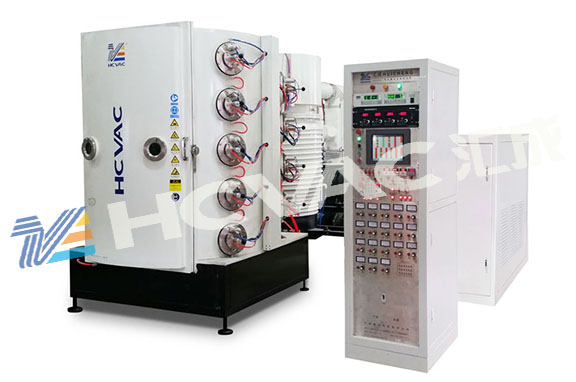PVD coating pvd coating machine technology is suitable for high-speed steel and carbide tools with various processing requirements and workpiece materials, so what are its advantages and characteristics? The following is a small series for you to introduce in detail:

1. Technical characteristics
(1) PVD film can be directly plated on stainless steel and cemented carbide. For relatively soft zinc alloy, copper, iron and other die-casting parts, chemical electroplating should be carried out first, and then PVD plating is suitable. However, it is easy to do PVD after water plating. Foaming, high defective rate;
(2) The typical processing temperature of PVD coating is between 250 ℃ ~ 450 ℃;
(3) The type and thickness of the coating determine the process time, and the general process time is 3 to 6 hours;
(4) The thickness of the PVD coating layer is micron-level, and the thickness is relatively thin, generally 0.3 μm ~ 5 μm, and the thickness of the decorative coating layer is generally 0.3 μm ~ 1 μm, so it can hardly affect the original size of the workpiece. Improve various physical and chemical properties of the workpiece surface, and can maintain the size of the workpiece basically unchanged, and no further processing is required after plating;
(5) PVD technology not only improves the bonding strength between the coating and the base material, but also the coating composition has been developed from the first generation of TiN to TiC, TiCN, ZrN, CrN, MoS2, TiAlN, TiAlCN, TiN-AlN, CNx, DLC and Multi-component composite coatings such as ta-C can form surface effects of different colors.
(6) The colors of the film layers that can be made at present include deep golden yellow, light golden yellow, brown, bronze, gray, black, gray black, seven colors, etc. By controlling the relevant parameters in the coating process, the plated color can be controlled; after the coating is completed, the color value can be measured with the relevant instrument, so that the color can be quantified to determine whether the plated color meets the requirements.
2. Technical advantages
(1) Good adhesion of the coating: During ordinary vacuum coating, there is almost no transition layer between the workpiece surface and the coating, which seems to be completely separated. In the case of ion plating, when the ions bombard the workpiece at a high speed, they can penetrate the surface of the workpiece and form a deep diffusion layer implanted into the substrate. The interface diffusion depth of ion plating can reach four to five microns. The test shows that the coating still stretches plastically along with the base metal until it is about to break, and no peeling or peeling occurs. It can be seen how firm the adhesion is, and the film layer is uniform and dense.
(2) Strong wrapping ability: During ion plating, the evaporating material particles move in the electric field along the direction of the electric field in the form of charged ions, so any part with an electric field can obtain a good coating, which is only better than ordinary vacuum coating. It is far superior to be able to obtain the coating in the direct direction. Therefore, this method is very suitable for coating internal holes, grooves and slits on parts. Parts that are difficult to be plated by other methods. Ordinary vacuum coating can only coat the direct surface, and the evaporating material particles can only go up the ladder like climbing a ladder; while ion plating can evenly coat the back of the part and the inner hole, and the charged ions are like sitting on the With a helicopter, it can fly to any place within its radius of activity along the prescribed route.
(3) Good coating quality: The ion-plated coating has a dense structure, no pinholes, no bubbles, and a uniform thickness. Even the facets and grooves can be plated uniformly without the formation of metal bumps. Parts such as threads can also be plated, with high hardness, high wear resistance (low friction coefficient), good corrosion resistance and chemical stability, etc., the life of the film is longer; at the same time, the film can be large. Significantly improve the appearance and decoration performance of the workpiece.
(4) Simplified cleaning process: Most of the existing PVD coating processes of pvd coating machines require strict cleaning of the workpiece in advance, which is complicated and time-consuming. However, the ion plating process itself has an ion bombardment cleaning effect that continues throughout the coating process. The cleaning effect is excellent, which can make the coating directly close to the substrate, effectively enhance the adhesion, and simplify a lot of pre-plating cleaning work.
(5) Wide range of plating materials:
pvd coating machine ion plating uses high-energy ions to bombard the surface of the workpiece, so that a large amount of electrical energy is converted into heat energy on the surface of the workpiece, thereby promoting the diffusion and chemical reaction of the surface tissue. However, the entire workpiece, especially the core of the workpiece, was not affected by the high temperature. Therefore, the application range of this coating process is wider, and the limitations are less. Generally, various metals, alloys and some synthetic materials, insulating materials, heat-sensitive materials and high-melting-point materials can be plated. Non-metal or metal can be plated on metal workpieces, metal or non-metal can also be plated on non-metal, and even plastic can be plated
, rubber, quartz, ceramics, etc.



